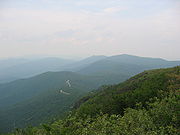
Eastern Wilderness Act
Encyclopedia

Act of Congress
An Act of Congress is a statute enacted by government with a legislature named "Congress," such as the United States Congress or the Congress of the Philippines....
93-622) was signed into law by President Gerald Ford
Gerald Ford
Gerald Rudolph "Jerry" Ford, Jr. was the 38th President of the United States, serving from 1974 to 1977, and the 40th Vice President of the United States serving from 1973 to 1974...
on January 3, 1975. Built upon the 1964 Wilderness Act
Wilderness Act
The Wilderness Act of 1964 was written by Howard Zahniser of The Wilderness Society. It created the legal definition of wilderness in the United States, and protected some 9 million acres of federal land. The result of a long effort to protect federal wilderness, the Wilderness Act was signed...
, which was written by Howard Zahniser
Howard Zahniser
Howard Clinton Zahniser was an American environmental activist. Zahniser is noted for being the primary author of the Wilderness Act of 1964....
of The Wilderness Society
The Wilderness Society (United States)
The Wilderness Society is an American organization that is dedicated to protecting America's wilderness. It was formed in 1935 and currently has over 300,000 members and supporters.-Founding:The society was incorporated on January 21, 1935...
and signed into law by President Lyndon B. Johnson
Lyndon B. Johnson
Lyndon Baines Johnson , often referred to as LBJ, was the 36th President of the United States after his service as the 37th Vice President of the United States...
, the Act designated 16 new wilderness areas in the eastern United States, including 207000 acres (837.7 km²) of wilderness on national lands in 13 states. Although originally untitled, the bill signed by Ford has come to be known as the Eastern Wilderness Act.
While the previous Act created the legal definition of wilderness
Wilderness
Wilderness or wildland is a natural environment on Earth that has not been significantly modified by human activity. It may also be defined as: "The most intact, undisturbed wild natural areas left on our planet—those last truly wild places that humans do not control and have not developed with...
in the United States, the Eastern Wilderness Act only applied to land east of the 100th Meridian.
Background
In 1964, both the Forest ServiceUnited States Forest Service
The United States Forest Service is an agency of the United States Department of Agriculture that administers the nation's 155 national forests and 20 national grasslands, which encompass...
and Congress
United States Congress
The United States Congress is the bicameral legislature of the federal government of the United States, consisting of the Senate and the House of Representatives. The Congress meets in the United States Capitol in Washington, D.C....
agreed that eastern areas would have qualified as wilderness. However, six years later, the Forest Service opposed congressional designation of new wilderness areas in West Virginia with land use histories of logging. In 1971, they adopted a "purity" interpretation for wilderness designation, meaning that no lands with a history of human disturbance, East or West, could qualify as wilderness.
The Forest Service drafted their own bill as an alternative, "to establish a system of wild areas within the land of the national forest system", which would have allowed cutting trees to "improve" wildlife habitat and recreation. The organization described the bill as necessary because Eastern areas "do not meet the strict criteria of the Wilderness Act". Members of Congress who championed the Wilderness Act resolved to overturn the misconception that wilderness areas only included those that were "pristine" in nature. Senator Henry Jackson warned of this "serious and fundamental misinterpretation of the Wilderness Act" and pledged himself to correct the falsity of the so-called purity theory. Senator Frank Church, who had been leader of the Senate debate on the Wilderness Act, observed that "the effect of such an interpretation would be to automatically disqualify almost everything, for few if any lands on this continent—or any other—have escaped man’s imprint to some degree".
To counteract the Forest Service bill, advocates for wilderness—including The Wilderness Society, the Sierra Club
Sierra Club
The Sierra Club is the oldest, largest, and most influential grassroots environmental organization in the United States. It was founded on May 28, 1892, in San Francisco, California, by the conservationist and preservationist John Muir, who became its first president...
, and Friends of the Earth
Friends of the Earth
Friends of the Earth International is an international network of environmental organizations in 76 countries.FOEI is assisted by a small secretariat which provides support for the network and its agreed major campaigns...
, and their congressional allies—responded with the proposed Eastern Wilderness Areas Act. Promoted largely by Ernie Dickerman
Ernie Dickerman
Ernest Miller Dickerman was an American wilderness advocate and conservationist. Known as the "Grandfather of Eastern Wilderness", he was particularly instrumental in securing legal protection for wild land in Virginia and eastern United States.-Early life and career:Born in Austin, Illinois,...
, a Wilderness Society staff member, and George Aiken
George Aiken
George David Aiken was an American politician from Vermont. A Republican, he served as the 64th Governor of Vermont from 1937 to 1941 and as a U.S. Senator from 1941 to 1975...
, a senator from Vermont, the Senate endorsed the wilderness bill in May 1974.
The final legislation adopted some elements of the Forest Service-inspired bill, but did not alter the definition and intent of the Wilderness Act of 1964. The previous debate regarding the meaning of "wilderness" versus "pristine" land led to the understanding that cultural use of lands should not keep the area from being restored to a "secondary wilderness" with functioning natural processes similar to when the land was in a primary state. Therefore, the Eastern Wilderness Areas Act not only explicitly protects lands which have suffered previous abuse, but that also have the ability to recover, and therefore be designated for wilderness protection.

